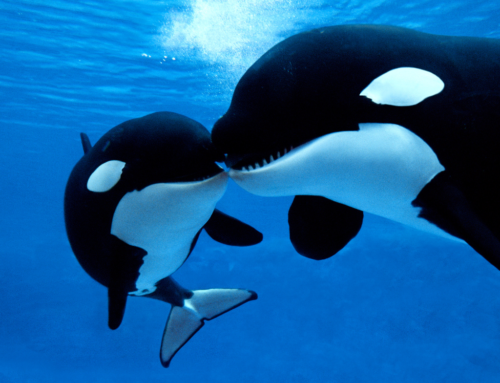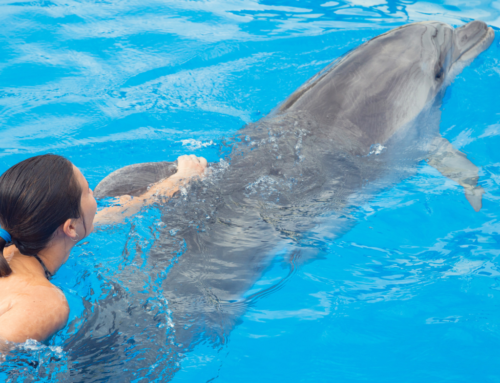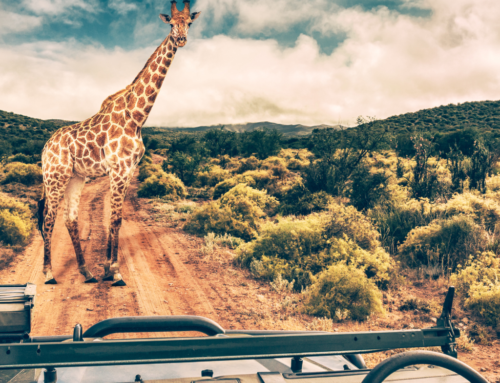
Seeing and experiencing wildlife is a major reason why I travel. There’s nothing like getting to experience a wild animal up close, especially in its natural habitat (or close to it). However, knowing which are ethical animal encounters and which should be avoided can be tricky. Luckily, there are plenty of ethical animal tourism activities out there that allow animal lovers to have fun and feel good about in the process.
Table of Contents
Volunteer at Elephant Nature Park, Thailand

Volunteering with elephants at the Elephant Nature Park
Visiting Elephant Nature Park is what inspired me to dive into the world of animal tourism education. The elephant sanctuary is consistently rated as one of the most ethical elephant destinations in the world. It’s founder, Lek Chailert, is an absolute legend and true wildlife warrior. She has challenged Southeast Asia’s traditions and laws surrounding elephants as well as fighting for the indigenous peoples whose lives rely on the gentile giants.
You can take a day trip to Elephant Nature Park from Chiang Mai, or spend varying amounts of time volunteering. Volunteers spend their days making food for the elephants, cleaning the grounds, and educating visitors on topics like elephant rides and circuses. If you have a background in veterinary medicine, vets and vet techs can volunteer their time and services to the park as well.
Go whale watching in Washington State, USA
Washington state is one of the best places in the world to see orcas and other whale species. In addition, the Pacific Ocean waters around the state are home to blue whales, humpback whales, and gray whales. There are dozens of whale watching tours in nothern Washington including right out of the harbor in Seattle. The state has strict laws about getting too close to the whales that boats must follow to prevent injury and stress to the animals and allow visitors to enjoy the magnificent creatures in their natural habitat.
Snorkel with ocean life in the Belize Barrier Reef

Snorkeling in the Belize Barrier Reef
The Belize Barrier Reef is the second largest barrier reef in the world and the largest in the western hemisphere. The reef is home to marine mammals such as dolphins and whale sharks as well as hundreds of species of fish, rays, sharks, and invertebrates. The country takes its ocean conservation very seriously, so finding an ethical snorkeling excursion is pretty easy.
While visiting Belize, you can also see wildlife when hiking the local Mayan ruins. The tiny country is home to diverse wildlife including 26 species of hummingbirds, multiple species of monkeys, as well as snakes, bats, and reptiles that can be easily spotted from boats and trails.
Go gorilla trekking in Bwindi Impenetrable National Park, Uganda
Gorilla trekking is a bucket list item for many wildlife lovers around the world. Luckily, nearly every trip you book to see the mountain gorillas in Uganda will be an ethical one. The country requires a permit for every single trekker that only allows them to trek with a licensed group and view the gorillas for one hour in the Bwindi Impenetrable Forest. While this may not seem like much time, it can take all day to find the gorillas and allows tourists to see them without overwhelming the animals.
Gorilla trekking tours have dramatically decreased poaching in the area, promoted conservation efforts, as well as created jobs for those that needed them. Without supervised gorilla trekking tours, the animals may have disappeared from the country completely. These positive impacts make gorilla trekking tours with credited companies one of the most ethical animal experiences a tourist can have.
Visit a tortoise hatchery in the Galápagos Islands

Hanging out with some tortoises in the Galápagos
Thanks to early pirates and whalers, the famous Galápagos tortoises nearly went extinct – in fact, some species did. However, thanks to impressive breeding programs and hatcheries combined with ethical tourism practices, many of the tortoise species are thriving and back in their natural habitat or taken care of in an animal sanctuary. There are multiple hatcheries and sanctuaries spread over the many islands, allowing you to visit one no matter which island you choose to visit. My favorite tortoise sanctuary was absolutely stunning and also had access to some lava tunnels for us to explore! It was a truly unforgettable experience that I will never forget.
Enjoy a Jeep safari in South Africa
South Africa’s Kruger National Park is one of the continent’s best places to see the big five: African elephants, leopards, lions, African buffalo, and black rhino. The park is also home to must-see wild animals such as giraffes, hippos, and cheetahs. To stay as ethical as possible, book tours directly with Kruger National Park rather than through a third party or hiring an outside guide. A qualified safari guide will know where to go to find wildlife but also keep the wildlife encounters safe and keep a distance from the animals to keep them comfortable and relaxed.
See wild Komodo dragons at Komodo Island, Indonesia
Komodo Island briefly closed when tourists were becoming too disruptive for the reptiles that live there. However, after some reevaluation and tweaking of the rules, the island is back in business and a more ethical destination to visit than before. Komodo dragons are one of the most fascinating reptile species in the world, and Komodo Island is the perfect place to see them! Just remember to keep a minimum of 6ft (2m) away from the animals and never feed or pet them.

SCUBA in the Great Barrier Reef, Australia
The Great Barrier Reef is the largest and most famous tropical reef in the world for good reason. The impressive piece of nature is essential for the health of not only Australia but our entire planet. It’s one of the seven wonders of the world, containing over 400 species of coral, 1500 species of fish, 200 species of birds, and other marine live including sea turtles and giant clams that are over 120 years old. Always follow your SCUBA rules and etiquette whether you are diving alone or with a tour group.
Hike the Cloud Forest in Costa Rica
The Monteverdes Cloud Forest located just outside Monteverdes, Costa Rica is one of the most unique destinations in the world. The constant cloud coverage creates a natural terrarium where plants and animals thrive. The Monteverde Biological Reserve offers educational tours through the canopy where 50% of the country’s already impressive biodiversity live.
Visit an AZA-accredited zoo or aquarium
Zoos often get a bad reputation due to unethical roadside animal attractions. However, there are major differences between zoological parks and aquariums that are accredited by the Association of Zoos and Aquariums (AZA) and those that are not. A captive animal is not unhappy when they are properly taken care of in the best possible way. Rest assured, if the park has the AZA’s approval, it is an overall ethical animal experience that can be educational and easier to visit than a trip abroad.
How to recognize ethical and unethical animal tourism encounters
Knowing what animal tourism destination, activity, or particular tour to participate in can be tricky. In general, avoid destinations that
- Allows guests to pet or hold the animals
- Allows guests to feed the animals
- Do not have space or enrichment for their animals
- Put on shows and performances
- Breed their animals outside of AZA breeding programs
There are exceptions to these rules. Some zoos have educational talks while allowing guests to feed giraffes or other animals under close supervision. Volunteers at sanctuaries often need to directly touch or feed the animals as a part of their job. In general, if you follow these guidelines you will be able to avoid many unethical animal encounters when traveling.
To learn more about ethical and unethical animal tourism, check out my other animal tourism articles or listen to my podcast!










Leave a Reply